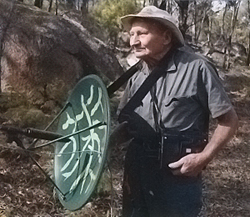|
|
|
Click on the thumbnails to go to the larger image.
|
Superb Lyrebird
Conservation status: Near Threatened
The Superb Lyrebird is the largest songbird on earth. It is an accomplished mimic and it often imitates other bird calls in its song. Superb Lyrebirds can also reproduce in its song any sound that it might have heard - such as chain saws, dogs barking and ambulance sirens! Both male and female lyrebirds sing, but the males sing more loudly and more often.
|
|
Scientific Classification
|
Class:
Order:
Family:
Genus:
Species:
|
Aves
Passeriformes
Menuridae
Menura
novaehollandiae
|
|
|
The Superb Lyrebird is a very large (80-100cm) ground-dwelling species that prefers to run away than fly when disturbed. Females are smaller than males.
Both males and females have a grey-brown body with reddish-brown wings. Males have an ornate tail, with two large, curved outer feathers that, when spread forward over the body in display, look like the arms of a lyre. Between these prominent feathers, the rest of the tail is made up of long, filamentous feathers which create a shimmering effect when shaken during the display. Females and juveniles also have long tails, but they lack the ornate feathers.
Lyrebirds can be found in rainforest or moist woodland areas of south-east Queensland, eastern New South Wales and Victoria. They have been introduced into Tasmania.
They roost at night in trees, but can be found during the daytime on the ground, scratching with their large, strong feet through the leaf litter looking for food. They eat worms, spiders and insects and sometimes seeds. The birds are usually solitary and live within a home-territory of about 10 km diameter.
Breeding season is in late Autumn, Winter and into Spring. During that time, male lyrebirds build a number of small, cleared mounds in their territory and attract potential mates by singing and dancing on top of the mounds. A male will mate with several females and the female might visit several males before she mates. The female builds a large, domed nest of sticks - usually above the ground in a tree stump or rock crevice and it is often camouflaged with ferns or moss. She lays a single egg and raises the chick by herself. The chick usually spends about nine months with its mother before moving on to establish its own territory.
Some observations by Bill Goebel.
- 1872 - At the Ballandean Post Office, Superb Lyrebirds could be heard calling.
- 1904 - the first foxes were noticed in the Ballandean area and the number's of lyrebird's dramatically dropped in the years to follow.
- 1950 - Queensland Museum were interested in the lyrebirds in Girraween and wanted a specimen. They eventually got a pair around 1958. (Governor Henry Able Smith saw the museum specimen and wanted to visit where it was collected. They camped out the back of Bill Goebel's, but unfortunately they didn't get to see or hear a single lyrebird).
- 1964-66 - A huge 1080 poisoning program to eradicate rabbits was conducted. Because they also poisoned cats and foxes, the number of lyrebirds seemed to explode.
|
Bill Goebel has recorded the lyrebirds songs since the early 1960's and through this has been able to see where each of the lyrebird populations originated.
In the 1950's there were only two locations of lyrebirds in the Girraween area (Sliprock and Mt Norman). The Mount Norman birds had a very distinct 'chip off the brick' call that later would be heard in areas such as South Bald Rock, Bald Rock, Racecourse Creek, the Dr Roberts' Waterhole area and, eventually, ending up behind Bill's house (almost meeting with the other populations). This population is the only one in Girraween that have kept their original call.
|
|

Bill Goebel recording lyrebird song.
|
| The Slip Rock population extended from Slip Rock to the current day Pugno and Williams properties and then west to Lyra. They kept the same call until the 1980 bushfire burnt out a lot of their country. They then moved to the Mount Norman side of the road and mixed in with the Mount Norman population, nowadays there are noises resembling 'dun Reynolds,' a squeaky windmill and 'witch doctor'. Interestingly White-eared Honeyeaters say "doctor witch". Bill seems to think this is where 'witch doctor' originated - it has been turned around.
There was a bounty on foxes until the 1990's, so the numbers seemed to be stable and spreading throughout Girraween NP. However it seems that Girraween's 2002 wildfire had a terrible effect on the lyrebirds on the northern side of Pyramids Road. Populations extending from West Bald Rock, including Middle Rock and South Bald Rock, to Bald Rock seem stable.
|
|

